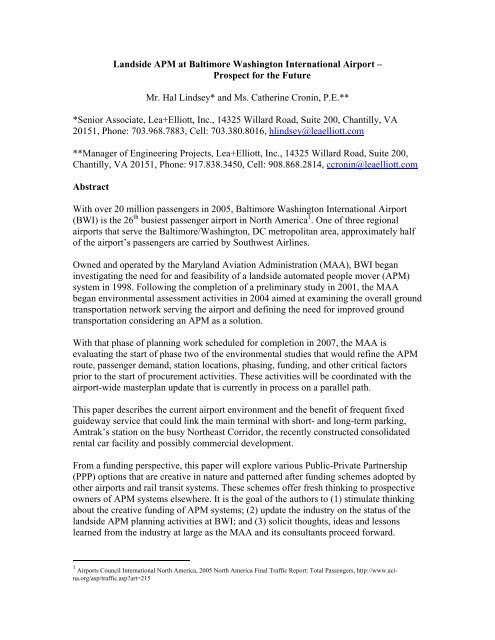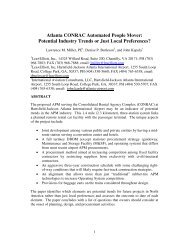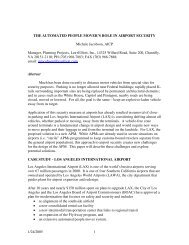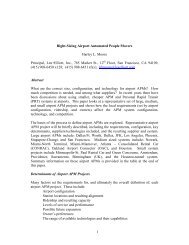Landside APM at Baltimore Washington International ... - Lea+Elliott
Landside APM at Baltimore Washington International ... - Lea+Elliott
Landside APM at Baltimore Washington International ... - Lea+Elliott
Create successful ePaper yourself
Turn your PDF publications into a flip-book with our unique Google optimized e-Paper software.
<strong>Landside</strong> <strong>APM</strong> <strong>at</strong> <strong>Baltimore</strong> <strong>Washington</strong> Intern<strong>at</strong>ional Airport –<br />
Prospect for the Future<br />
Mr. Hal Lindsey* and Ms. C<strong>at</strong>herine Cronin, P.E.**<br />
*Senior Associ<strong>at</strong>e, <strong>Lea+Elliott</strong>, Inc., 14325 Willard Road, Suite 200, Chantilly, VA<br />
20151, Phone: 703.968.7883, Cell: 703.380.8016, hlindsey@leaelliott.com<br />
**Manager of Engineering Projects, <strong>Lea+Elliott</strong>, Inc., 14325 Willard Road, Suite 200,<br />
Chantilly, VA 20151, Phone: 917.838.3450, Cell: 908.868.2814, ccronin@leaelliott.com<br />
Abstract<br />
With over 20 million passengers in 2005, <strong>Baltimore</strong> <strong>Washington</strong> Intern<strong>at</strong>ional Airport<br />
(BWI) is the 26 th busiest passenger airport in North America 1 . One of three regional<br />
airports th<strong>at</strong> serve the <strong>Baltimore</strong>/<strong>Washington</strong>, DC metropolitan area, approxim<strong>at</strong>ely half<br />
of the airport’s passengers are carried by Southwest Airlines.<br />
Owned and oper<strong>at</strong>ed by the Maryland Avi<strong>at</strong>ion Administr<strong>at</strong>ion (MAA), BWI began<br />
investig<strong>at</strong>ing the need for and feasibility of a landside autom<strong>at</strong>ed people mover (<strong>APM</strong>)<br />
system in 1998. Following the completion of a preliminary study in 2001, the MAA<br />
began environmental assessment activities in 2004 aimed <strong>at</strong> examining the overall ground<br />
transport<strong>at</strong>ion network serving the airport and defining the need for improved ground<br />
transport<strong>at</strong>ion considering an <strong>APM</strong> as a solution.<br />
With th<strong>at</strong> phase of planning work scheduled for completion in 2007, the MAA is<br />
evalu<strong>at</strong>ing the start of phase two of the environmental studies th<strong>at</strong> would refine the <strong>APM</strong><br />
route, passenger demand, st<strong>at</strong>ion loc<strong>at</strong>ions, phasing, funding, and other critical factors<br />
prior to the start of procurement activities. These activities will be coordin<strong>at</strong>ed with the<br />
airport-wide masterplan upd<strong>at</strong>e th<strong>at</strong> is currently in process on a parallel p<strong>at</strong>h.<br />
This paper describes the current airport environment and the benefit of frequent fixed<br />
guideway service th<strong>at</strong> could link the main terminal with short- and long-term parking,<br />
Amtrak’s st<strong>at</strong>ion on the busy Northeast Corridor, the recently constructed consolid<strong>at</strong>ed<br />
rental car facility and possibly commercial development.<br />
From a funding perspective, this paper will explore various Public-Priv<strong>at</strong>e Partnership<br />
(PPP) options th<strong>at</strong> are cre<strong>at</strong>ive in n<strong>at</strong>ure and p<strong>at</strong>terned after funding schemes adopted by<br />
other airports and rail transit systems. These schemes offer fresh thinking to prospective<br />
owners of <strong>APM</strong> systems elsewhere. It is the goal of the authors to (1) stimul<strong>at</strong>e thinking<br />
about the cre<strong>at</strong>ive funding of <strong>APM</strong> systems; (2) upd<strong>at</strong>e the industry on the st<strong>at</strong>us of the<br />
landside <strong>APM</strong> planning activities <strong>at</strong> BWI; and (3) solicit thoughts, ideas and lessons<br />
learned from the industry <strong>at</strong> large as the MAA and its consultants proceed forward.<br />
1 Airports Council Intern<strong>at</strong>ional North America, 2005 North America Final Traffic Report: Total Passengers, http://www.acina.org/asp/traffic.aspart=215
BWI by Definition<br />
Opened and dedic<strong>at</strong>ed for use in 1950 by President Harry S. Truman, the current BWI<br />
Airport was originally named Friendship Intern<strong>at</strong>ional Airport. In 1972, the St<strong>at</strong>e of<br />
Maryland Department of Transport<strong>at</strong>ion (MDOT) purchased the airport from the City of<br />
<strong>Baltimore</strong> and renamed it in 1973. Now managed by the MAA, a division of MDOT,<br />
BWI is one of the largest economic gener<strong>at</strong>ors in the st<strong>at</strong>e, contributing approxim<strong>at</strong>ely<br />
$5.7 billion annually to the st<strong>at</strong>e’s economy. 2<br />
Sited on 3,600 acres, the airport today serves more than 20 million annual passengers<br />
with 70 jet g<strong>at</strong>es and 12 g<strong>at</strong>es dedic<strong>at</strong>ed to commuter aircraft loc<strong>at</strong>ed in 4 domestic<br />
concourses and 1 intern<strong>at</strong>ional concourse. Over 25,000 regular parking spaces are<br />
provided for BWI passengers with another 7,500 available to handle peak travel periods. 3<br />
From a regional transport<strong>at</strong>ion and accessibility standpoint, BWI is well served by I-95,<br />
one of the highest capacity interst<strong>at</strong>es along the east coast of the United St<strong>at</strong>es; Amtrak’s<br />
busy Northeast Corridor, high-speed rail linking <strong>Washington</strong>, DC with <strong>Baltimore</strong>,<br />
Philadelphia, New York, Boston and points between; regional light rail transit oper<strong>at</strong>ed<br />
by the Maryland Transport<strong>at</strong>ion Administr<strong>at</strong>ion (MTA); and local and regional bus lines.<br />
BWI is loc<strong>at</strong>ed 10 miles south of <strong>Baltimore</strong> and 30 miles north of <strong>Washington</strong>, DC,<br />
str<strong>at</strong>egically positioned to serve the gre<strong>at</strong>er <strong>Baltimore</strong>/<strong>Washington</strong>, DC metropolitan area<br />
and its 8+ million residents.<br />
Figure 1 4 : <strong>Baltimore</strong>/<strong>Washington</strong>, DC<br />
Metropolitan Area Airports<br />
Figure 2 5 : BWI Airport Layout<br />
2 Maryland Avi<strong>at</strong>ion Administr<strong>at</strong>ion (MAA) website, BWI Timeline, http://www.bwiairport.com/about_bwi/bwi_timeline/<br />
3 MAA website, General St<strong>at</strong>istics, http://www.bwiairport.com/about_bwi/general_st<strong>at</strong>istics/<br />
4 Visiting DC.com, BWI Airport, http://www.visitingdc.com/airport/washington-dc-airport-map.htm<br />
5 Courtesy URS Corpor<strong>at</strong>ion
<strong>APM</strong> Planning (2000-2001) 6<br />
Figure 3: Feasibility<br />
Study for MAA<br />
In response to the airport’s rapid growth (six percent annual<br />
increase in passenger trips) in the decade between 1990 and<br />
2000, and as part of the airport’s capital five-year, $1.8 billion<br />
expansion and improvement program called VISION, MAA<br />
commissioned a feasibility study for a landside <strong>APM</strong> system in<br />
2000.<br />
The Study initially evalu<strong>at</strong>ed eight altern<strong>at</strong>ives (route and<br />
technology pairings). Of these eight, two <strong>APM</strong> altern<strong>at</strong>ives<br />
were selected for further study. Each altern<strong>at</strong>ive included<br />
multiple st<strong>at</strong>ions in the Main Terminal area, and linkages to long<br />
term parking, a proposed Intermodal Center (for transfer to<br />
regional light rail transit and bus), the Amtrak BWI rail st<strong>at</strong>ion and the consolid<strong>at</strong>ed<br />
rental car facility <strong>at</strong> Stoney Run. A second line extended from the main terminal area to<br />
the long term parking lots to the east.<br />
As conceived, the full system was approxim<strong>at</strong>ely 5.6 miles long with 16 st<strong>at</strong>ions. It was<br />
envisioned th<strong>at</strong> nearly all of the dual-lane guideway would be elev<strong>at</strong>ed. MAA concluded<br />
the study in April 2001 examining primarily candid<strong>at</strong>e vehicle technologies and<br />
altern<strong>at</strong>ive alignments for an <strong>APM</strong> system.<br />
Prior to any further action to progress the <strong>APM</strong> <strong>at</strong> BWI, the events of 9/11 took place.<br />
The airline industry underwent a recession and passenger numbers <strong>at</strong> all airports dropped<br />
significantly. As such, the pressure to quickly improve ground transport<strong>at</strong>ion <strong>at</strong> BWI to<br />
meet the high levels of passenger growth they were experiencing eased. MAA took this<br />
opportunity to reintegr<strong>at</strong>e the work th<strong>at</strong> was happening on the <strong>APM</strong> with the overall<br />
master planning efforts being undertaken for the airport.<br />
<strong>APM</strong> Environmental Assessment and Preliminary Engineering (2004 – Current)<br />
In December 2004, MAA began a new study to assess and document any need for an<br />
improved ground transport<strong>at</strong>ion system, considering an <strong>APM</strong> as a potential solution.<br />
MAA initi<strong>at</strong>ed this study to ensure th<strong>at</strong> it maintains easy accessibility in the future and<br />
continues to be known as an “easy-come, easy-go” airport as air traffic and ground<br />
transport<strong>at</strong>ion traffic increases in future years. This first phase of the study focused on an<br />
analysis of the entire ground transport<strong>at</strong>ion system, the existing and future transport<strong>at</strong>ion<br />
problems, and the potential solutions including <strong>APM</strong>.<br />
As part of assessing the possible need for implement<strong>at</strong>ion of an <strong>APM</strong> <strong>at</strong> BWI, or for other<br />
improvements to the ground transport<strong>at</strong>ion system, interviews were held with parties who<br />
6 Parsons Brinckerhoff Quade & Douglas, Inc. and <strong>Lea+Elliott</strong>, Inc., BWI <strong>Landside</strong> Improvements People Mover Feasibility Study,<br />
January 19, 2001
have an interest in the development of the Airport and its oper<strong>at</strong>ion. General consensus of<br />
the interviewees was th<strong>at</strong> some type of improvements to the ground transport<strong>at</strong>ion<br />
network would be needed in the future. Beyond th<strong>at</strong> sentiment, two key points emerged<br />
from the interviews:<br />
1) Regardless of the ground transport<strong>at</strong>ion mode ultim<strong>at</strong>ely pursued, the system<br />
must be developed within the framework of the Airport’s master planning<br />
initi<strong>at</strong>ives, and<br />
2) Cost of design, construction and oper<strong>at</strong>ion of an <strong>APM</strong> is a primary concern<br />
and implement<strong>at</strong>ion of a system must be done in an efficient, competitive<br />
manner if it is to work <strong>at</strong> BWI.<br />
The first phase of work also included evalu<strong>at</strong>ion of the st<strong>at</strong>e of the industry rel<strong>at</strong>ed to<br />
<strong>APM</strong> development <strong>at</strong> other airports in North America, collection of existing<br />
environmental d<strong>at</strong>a and prepar<strong>at</strong>ion of environmental resource inventory maps to be used<br />
in future analysis of the <strong>APM</strong> corridor, and an evalu<strong>at</strong>ion of four different ground<br />
transport<strong>at</strong>ion scenarios. Specifically, the study looked <strong>at</strong> the following four altern<strong>at</strong>ives:<br />
Altern<strong>at</strong>ive 1: No Build: Assumed only roadway improvements adopted in the<br />
region’s 2030 Constrained Long-Range Plan (CLRP).<br />
Altern<strong>at</strong>ive 2: Roadway Capacity Enhancements: Rel<strong>at</strong>ively modest capital<br />
improvements to improve traffic conditions <strong>at</strong> isol<strong>at</strong>ed loc<strong>at</strong>ions in the study area.<br />
Altern<strong>at</strong>ive 3: <strong>APM</strong>: Implement<strong>at</strong>ion of an <strong>APM</strong> to serve the Airport.<br />
Altern<strong>at</strong>ive 4: Ground Transport<strong>at</strong>ion System Enhancements: More<br />
substantial capital improvements to serve various BWI shuttles including<br />
provision of a consolid<strong>at</strong>ed ground transport<strong>at</strong>ion center.<br />
The specific items of work completed as part of the first phase of the environmental<br />
assessment and preliminary engineering effort included:<br />
• Meetings with stakeholders of the BWI community, including the MAA, St<strong>at</strong>e<br />
Highway Administr<strong>at</strong>ion (SHA), other MDOT personnel, Anne Arundel County,<br />
the Gre<strong>at</strong>er <strong>Baltimore</strong> Committee/<strong>Baltimore</strong> Transit Alliance, Delta and<br />
Southwest Airlines, the BWI Development Council, the BWI Business<br />
Partnership, Amtrak, and MTA.<br />
• A benchmarking report outlining the current and planned usage of <strong>APM</strong>s <strong>at</strong><br />
medium- and large-hub airports within North America.<br />
• Existing transport<strong>at</strong>ion facilities as they rel<strong>at</strong>e to roadway usage, Amtrak<br />
ridership, light rail ridership, BWI shuttles, shuttles other than those oper<strong>at</strong>ed by<br />
BWI, limousines, taxis, etc., parking garage and parking lot were c<strong>at</strong>aloged and<br />
analyzed.
• Relevant ground transport<strong>at</strong>ion system usage and passenger forecasts were<br />
compiled and analyzed. Traffic counts were performed to fill in any remaining<br />
d<strong>at</strong>a needs.<br />
• An environmental inventory of existing conditions of MAA-owned property in<br />
prepar<strong>at</strong>ion for the next phase of work was compiled.<br />
• Future ground transport<strong>at</strong>ion conditions were determined using air passenger<br />
forecasts provided by MAA, as well as inform<strong>at</strong>ion on Airport employee-use<br />
p<strong>at</strong>terns and growth projections, and ground transport<strong>at</strong>ion forecasts (autos,<br />
transit, rental car oper<strong>at</strong>ions, shuttles, etc.).<br />
• Altern<strong>at</strong>ives to address future potential ground transport<strong>at</strong>ion issues were<br />
developed: (1) No-Build, (2) Roadway Capacity Enhancements, (3) <strong>APM</strong>, and<br />
(4) Ground Transport<strong>at</strong>ion System Enhancements.<br />
• Ridership demand estim<strong>at</strong>es for a potential future <strong>APM</strong> were modeled, as were<br />
the projected shuttle bus needs.<br />
The result of the phase one analyses determined the following:<br />
• Altern<strong>at</strong>ive 1 – No-Build altern<strong>at</strong>ive does not address the growing traffic<br />
congestion on either the public roadway network or within the terminal area<br />
roadways. Traffic congestion on the surrounding roadway network of BWI<br />
Airport is already failing in current conditions and will continue to fail with the<br />
CLRP improvements sl<strong>at</strong>ed for development by 2030.<br />
• Altern<strong>at</strong>ive 2 – Roadway Capacity Enhancements provide relief from traffic<br />
congestion problems on the local roadway network but do not allevi<strong>at</strong>e the future,<br />
increased levels of shuttle traffic within the Airport roadways and terminal<br />
curbside areas.<br />
• Altern<strong>at</strong>ives 3 and 4 – <strong>APM</strong> System and Ground Transport<strong>at</strong>ion System<br />
Enhancements both provide relief from traffic congestion with the additional<br />
benefit of reducing the amount of shuttle traffic using the local roadways and<br />
impacting the terminal curbside area. Both Altern<strong>at</strong>ive 3 and Altern<strong>at</strong>ive 4 are<br />
justifiable development scenarios, as the airport will gener<strong>at</strong>e enough traffic for<br />
each of these systems to be a viable altern<strong>at</strong>ive.<br />
From a global perspective, it is clear th<strong>at</strong> something more than a ‘No-Build’ Altern<strong>at</strong>ive<br />
is necessary. The build altern<strong>at</strong>ives analyzed have the ability to provide mitig<strong>at</strong>ion of the<br />
ground transport<strong>at</strong>ion system challenges. Much of the decision for a recommended<br />
altern<strong>at</strong>ive needs to be based on two factors: (1) a policy decision on the desired level of<br />
service the Airport wants to provide to its users, and (2) how the altern<strong>at</strong>ives integr<strong>at</strong>e<br />
with the long-term Airport layout likely to be developed during the concurrent LRNA<br />
process.
Next Steps<br />
The overall recommend<strong>at</strong>ion of a final ground transport<strong>at</strong>ion system altern<strong>at</strong>ive will not<br />
be finalized until the development of the preferred LRNA plan; however, there are<br />
several steps th<strong>at</strong> can be taken in prepar<strong>at</strong>ion. Future task assignments include<br />
compar<strong>at</strong>ive evalu<strong>at</strong>ion of the altern<strong>at</strong>ive transport<strong>at</strong>ion system enhancements, upd<strong>at</strong>es to<br />
reflect the approved long-range needs assessment forecast, development of interim year<br />
forecasts as appropri<strong>at</strong>e, and development of budget cost estim<strong>at</strong>es for recommended<br />
altern<strong>at</strong>ives. The final concept definition study will be a consolid<strong>at</strong>ed document th<strong>at</strong> is<br />
coordin<strong>at</strong>ed with and can be integr<strong>at</strong>ed into the Airport’s upcoming LRNA and will<br />
include detailed planning of a recommended altern<strong>at</strong>ive; construction, and oper<strong>at</strong>ing and<br />
maintenance costs; and associ<strong>at</strong>ed environmental document prepar<strong>at</strong>ion.<br />
Potential Funding and Financing Scenarios<br />
There are a number of ways th<strong>at</strong> the capital and oper<strong>at</strong>ions and maintenance (O&M) costs<br />
of an <strong>APM</strong> system can be obtained. As the airport owner, MAA must evalu<strong>at</strong>e these and<br />
other options in light of enabling st<strong>at</strong>e legisl<strong>at</strong>ion (<strong>at</strong> the moment, specific st<strong>at</strong>e<br />
legisl<strong>at</strong>ion is not in place th<strong>at</strong> expressly authorizes PPPs for transport<strong>at</strong>ion infrastructure);<br />
MDOT, MAA and Federal Avi<strong>at</strong>ion Administr<strong>at</strong>ion regul<strong>at</strong>ions; the economic clim<strong>at</strong>e <strong>at</strong><br />
the time; their ability and interest in sharing risks and responsibility for system financing<br />
with the priv<strong>at</strong>e sector; and their own budgetary policies.<br />
The purpose of this section of the document is to highlight a range of methods th<strong>at</strong> could<br />
be used. The options range from very low risk on the part of the MAA to more risksharing<br />
with one or more priv<strong>at</strong>e sector teams. As risks are moved from the public sector<br />
to the priv<strong>at</strong>e sector, there is typically an increase in price. Further, public entities like<br />
MAA can usually borrow money <strong>at</strong> a lower r<strong>at</strong>e than priv<strong>at</strong>e sector companies but<br />
sometimes find it preferable to finance large projects through the priv<strong>at</strong>e sector from a<br />
cash flow and budgeting standpoint. The examples below are simply and solely shown as<br />
examples to stimul<strong>at</strong>e further thought and discussion.<br />
Figure 4: <strong>APM</strong> System Funding and Financing Scenarios<br />
Option<br />
Number<br />
Option 1<br />
Option 2<br />
Type of Procurement<br />
Design-Build-Oper<strong>at</strong>e-<br />
Maintain<br />
(DBOM)<br />
Build-Oper<strong>at</strong>e-Transfer<br />
(BOT)<br />
Complete System<br />
Infrastructure<br />
Financed By<br />
MAA<br />
Priv<strong>at</strong>e Sector<br />
Rolling Stock and<br />
System Financed By<br />
MAA<br />
Priv<strong>at</strong>e Sector<br />
Comments<br />
Large outlay required<br />
during construction years<br />
with much smaller<br />
amount during O&M<br />
Removes large initial<br />
outlay and cre<strong>at</strong>es fl<strong>at</strong> fee.<br />
If the system is free to the<br />
user, a method of shadow<br />
tolling will have to be<br />
derived so th<strong>at</strong> the O&M<br />
costs can be fairly<br />
alloc<strong>at</strong>ed.
Option<br />
Number<br />
Option 3<br />
Option 4<br />
Type of Procurement<br />
Partial Build-Oper<strong>at</strong>e-<br />
Transfer<br />
(BOT)<br />
Rolling Stock and System<br />
Components subject to<br />
BOT;<br />
Infrastructure designed<br />
and built by MAA<br />
PPP where MAA trades<br />
land and/or commercial<br />
development rights along<br />
<strong>APM</strong> right-of-way to<br />
offset <strong>APM</strong> capital and<br />
O&M costs.<br />
Infrastructure<br />
Financed By<br />
MAA<br />
MAA or Priv<strong>at</strong>e<br />
Sector<br />
Rolling Stock and<br />
System Financed By<br />
Priv<strong>at</strong>e Sector<br />
MAA or Priv<strong>at</strong>e<br />
Sector<br />
Comments<br />
MAA retains control of<br />
design and construction of<br />
technology-neutral<br />
guideway, st<strong>at</strong>ions and<br />
maintenance facility;<br />
multiple <strong>APM</strong><br />
technologies can fit on<br />
guideway. Reduces initial<br />
capital cost by<br />
approxim<strong>at</strong>ely 30%.<br />
Commercial development<br />
along <strong>APM</strong> right-of-way<br />
reduces capital and O&M<br />
costs of system over the<br />
life of the system<br />
Traditional funding sources for large MAA capital programs usually include airport<br />
revenue bonds, Passenger Facility Charges, and Airport Improvement Program funds<br />
obtained from the FAA.<br />
Conclusion / Summary<br />
MAA and its consultant team will continue work over the next one to two years to<br />
determine the most optimal solution to the airport’s ground transport<strong>at</strong>ion needs. Should<br />
an <strong>APM</strong> system be determined to be the best solution, MAA will engage the transit<br />
industry in further dialogue and discussion as to how it will proceed so as to stimul<strong>at</strong>e<br />
competition and procure the best value system for the airport’s near-, mid- and long-term<br />
needs.<br />
Acknowledgments<br />
This paper reflects the views of the authors and not necessarily those of <strong>Lea+Elliott</strong>, Inc.<br />
The authors thank Jordan Schwartz of The World Bank Group and C<strong>at</strong>herine Berns of<br />
<strong>Lea+Elliott</strong>, Inc. for their contributions to this paper.








